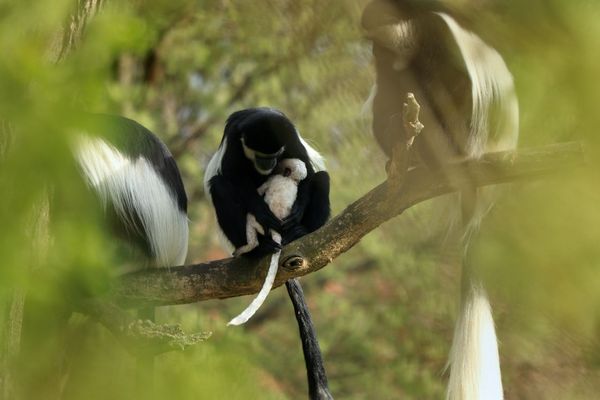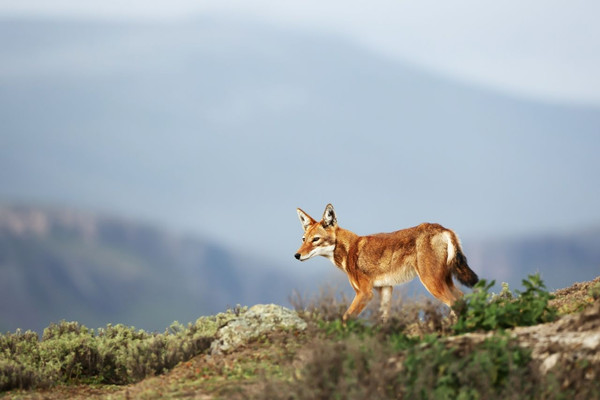Gelada Baboons, Ethiopia
News from Ethiopia

Operations Manager
28th June 2020
I arrived in Addis Ababa early in the morning, and the following day flew straight up to the northern city of Gondar, then drove on to the Simien Mountains. The Simiens are simply stunning, and all of our tours stay at Simien Mountain Lodge which is proud to be the highest lodge in Africa at 3,260m. You can certainly feel the altitude – I (embarrassingly!) felt a little out of breath walking the tiny distance uphill to my room when I first arrived – but the walks are short and you can drive through the National Park too, meaning you don’t need to exert a huge amount of energy to see the mountains and resident wildlife. Other than soaking up the breathtaking scenery, my priority here was to spend time among the huge troops of Gelada Baboons, which are endemic to Ethiopia and the most sociable of African monkeys. They spend their nights in precarious spots on the steep cliffs – where they are safe from predators – and in the morning climb up over the escarpment to graze the grasslands in huge herds. Before I travelled, I received some excellent advice to not follow the baboons, but to find them, and then sit, wait, and let them “flow” around me. I did just that, and what an amazing experience it was. There must have been hundreds of individuals in the herd, gradually moving over the grasslands, plucking the grass and chatting noisily together. They were completely un-phased as I sat watching them move around me. Set against such stunning scenery, I was worried my trip had peaked on Day 2!

As usual, my apprehension was unnecessary. After a couple of days in the north I returned to Addis and set off for Awash National Park. I visited a Hyena Cave, watching several Spotted Hyenas emerge as dusk approached, before spending the night at the lovely Awash Falls Lodge. This lodge is basic, but incredibly authentic, set right next to the falls so you fall asleep to the distant roar of the water. Another highlight followed the next morning, with an early morning bird walk along the river offering all sorts of wonderful sightings, including Cardinal Woodpecker, White-throated Bee-eaters, Didrick and Klass’s Cuckoos, Ruppell’s Weavers busily building their nests, Blue-naped Mousebird and Nile Valley Sunbird… to name just a few.


From here I continued south to the Bale Mountains. I split my stay between the ex-government hotel in Goba – a rather perfunctory place but well located for trips to the Sanetti Plateau – and Bale Mountain Lodge, a beautiful lodge located about 2 hours’ drive over the plateau and down the Harenna escarpment, with gorgeous views from the individual rooms across the forest. Here the mammal sightings really started ramping up – the endemic Mountain Nyala, Bohor Reedbuck, Starck’s Hare, Giant Mole Rat, Giant Forest Hog and Menelik’s Bushbuck were all quickly added to my trip list. Many people ask me, before they book, how likely they are to see Ethiopian Wolf. Well, that morning, driving over the Senetti Plateau, I saw 6! That included one individual, then a family of four (with one of the parents desperately trying to catch a hidden rat for its two cubs which were larking about nearby), and then another individual. So whilst I’d never make any promises… the wolves definitely do their best to make it easy for us! What really took me by surprise in the Bale Mountains was the contrasting scenery. Driving past the park headquarters, you could easily be forgiven for thinking you were in the Scottish highlands (except for the Warthogs running by and the endemic Blue-winged Geese sitting on the little roadside ponds). On the Sanetti Plateau, the highest point of which is at 4,377m, the landscape turns into rugged moorland, interspersed with strange-looking Giant Lobelias and Red-hot Pokers. Then, descending over the escarpment into the Harenna Forest, I found myself back in a world of lush, green vegetation, with Eastern Black-and-White Colobus Monkeys leaping overhead and a whole plethora of endemic birds to catch up with. It was quite a feast for the senses to experience so much in just one day!


Finally, I returned to Addis via the Great Rift Valley, stopping at Lakes Awassa and Langano. At the latter we almost always opt to stay at a lovely eco-lodge called Hara Langano, set beside the lake with resident Hippos nearby. Although there are few birds actually on the water, the forests here are a delight, and a couple more evening and early morning bird walks were the perfect way to round off my adventure.
Travelling around Ethiopia it dawned on me that my greatest impression of the country comes from Band Aid and the famine relief effort of 1985. Over 30 years on, I think it’s fair to say that many people in the UK have that same picture in their minds when they think of Ethiopia – starving children with distended bellies and a barren land where “nothing ever grows”. And it simply isn’t true; Ethiopia is a stunningly beautiful and, importantly, self-sufficient agricultural nation. The people are poor in comparison to Western nations, and life is hard work for many, but they form an incredibly warm, friendly and hospitable nation, with a fascinating culture and history. In some places the accommodation is pretty basic, and in some the service fell apart at times (I ordered fish stew, halfway through my meal concluded it was most definitely chicken, and later clocked the moment when the waitress reached the same conclusion and laughed nervously with my guide). But I found all of that to be easily forgivable in a country that is so welcoming, and full of warm and friendly people, beautiful scenery and fascinating wildlife.Over the last couple of years there have been intermittent political strikes and protests, some of which caused the UK foreign office to advise against travel to Addis and the surrounding region at times. So it was wonderful to travel just a couple of weeks after the election of the new prime minster, and to find absolutely everyone I asked to be glowing with admiration for their new premier. The mood was incredibly positive, their State of Emergency has now been lifted, and everyone is confident that the recent protests and strikes are now firmly in the past. So, there has perhaps never been a better time to travel to Ethiopia, and to see for yourself what this beautiful country has to offer!”
Our Ethiopia group tours run from October to March, and we organise tailormade holidays throughout the year. For more information please email This email address is being protected from spambots. You need JavaScript enabled to view it. or call Kerrie on 01962 733051.



 Loading search...
Loading search...